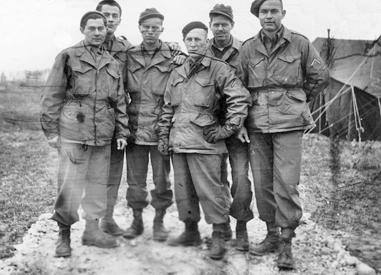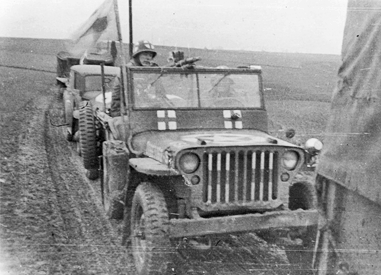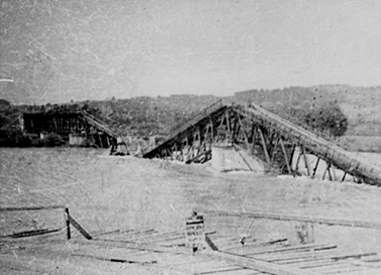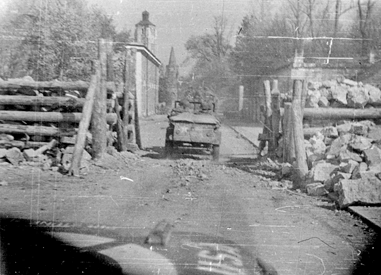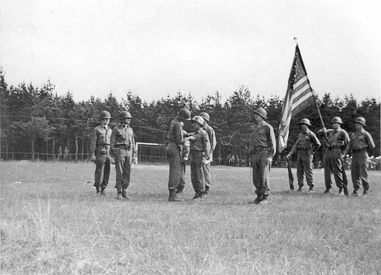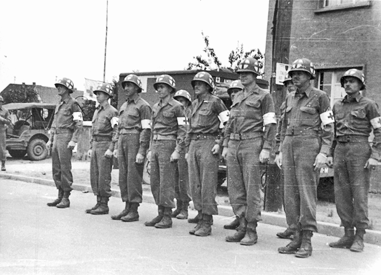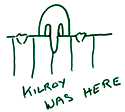| Join | Official Historian | City of Stamford | Blog | About Us | |
| Jewish Historical Society | Civil War Roundtable | Contact Us | |
|
|
|
|
The Stamford Historical Society PresentsPride and Patriotism: Stamford’s Role in World War II
|
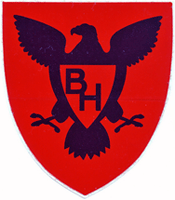 The 343rd emblem |
When we were in France before we went into combat, we were told proudly, and this was by a briefing officer to our battalion, 3rd Battalion, 343rd Regiment of the 86th Infantry, that the 51st Highlander, the American 101st did never took a POW, and we were expected to emulate this. At this point I was a PFC and a platoon aide man.
Orders were to take no SS POWs. As a medic these did not apply to me, but the fellows in my platoon kept scorecards on the number of SS they caught that day, and you identified an SS either by his uniform or the tattoo under his arm, if he had the tattoo or the uniform, the order were he was not to get back to POW cage.
I subsequently checked with people from other regiments of my division, infantry, and yes they also got rid of SS, primarily at this time, because the SS used to target the red crosses on our helmets, as a medic we had four red crosses and this became a target area.
Originally I was a litter bearer, but I became platoon aide man, so I would not leave the platoon. Our worst day in combat was when our artillery general was where he was not supposed to be. He was ordered/advised not to go there, but went anyway, and was captured. He had all the maps with our positions, he had all the radios and an American speaking German happened to be in the unit that captured him and radioed in the directions to our artillery that zeroed in on us…that was our worst day in combat. When our own artillery hit us. Command thought it was legitimate. An artillery map is divided into 1000 yard grids and they gave our grid location, so 3rd battalion that day had horrendous casualties…friendly fire. Most of our casualties were friendly fire or accidents.
Patton wanted to cut off the bulge at the neck during the Battle of the Bulge and Ike didn’t do that, they did frontal assault, which caused the greatest number of causalities, and this is when we actually lost most of the troops.
Other thing – Comm. Z… communication zone well behind the lines, they were well equipped, had everything…we went into combat with inferior clothing, inferior gloves…and we got one hot meal every six days…
The morning we went into combat in the Ruhr Valley we got powdered eggs and bacon, greasy as hell…and powdered milk which was terrible. We went forward in two lines of troops and I was at the tail end, I’m riding on the tail of a jeep, with my litter and we noticed, stupidly, that we were being shot at and we can see the 20mm ack-ack shells ricocheting over our heads. So the jeep I’m riding in had a 30caliber machine gun…no one in the squad had binoculars…I had lifted a pair in Cologne, Germany, so with my red crosses illegally I’m sitting fire for the 30 caliber machine gun and you shoot at the high point. This was in Attendorn – highest point was the church steeple, so we shot it off and it wasn’t repaired till 15 yrs later…Firing continued.
We went back to Aachen, at this point in American hands, first taken…we had retaken it from the Germans who had earlier retaken it from us. Nothing was standing in 1945, totally flat.
We stopped fighting on May, 2 1945. We were essentially out of ammunition and out of gas, but we were already beyond the line that the American forces were supposed to reach in Austria. After we stopped, a few survivors would come out of the woodwork, people who were Jews who had been hidden by various local villagers. We were never in the cities, the cities were reserved for so-called main divisions. Since we were newcomers, we got the boondock areas. At this time the existence of slave labor camps was known to us, but not the death camps. Principal slave laborers were civilians of either Italian, Russian etc. extraction.
We always treated civilians as medics. Once when an angry, drunk American medic, wanting revenge for a cousin killed in Italy wanted to shoot six Germans, the medics subdued him. Wehrmacht, German army POWs were treated according to the Geneva convention.
In fact, I once took two Germans myself. I pulled out my trusty bandage scissors and pointed to the rear and they happily surrendered. Germans were anxious to surrender to the Americans and not to the Russians. We allowed an extremely large number of Germans to go through our lines. This was back in Austria. Parts of the division went to Berchtesgaden. We were allowed to make a few trips and I went to Dachau, outside Munich. Here the ovens had not been put into use. The drainage ditch was there for the blood because they were killing by machine-gunning all Russian prisoners. But the gas chambers there had not been utilized. Manual killing only…gunfire, not the gas chambers.
We were not permitted to enter one village because officers were trying to protect us from seeing Germans hanged by the SS from lampposts for refusing to fight. This was the remnant of the SS where it was thought the SS was going to concentrate to maintain some form of guerrilla warfare in the Austrian Alps.
June 15 to17 we were pulled back to Mannheim Germany. We forced Russians to go back to Russia on trains…with great regret…they were treated horribly. I did nothing else in Mannheim, had some parades and medal ceremonies.
I went into combat at 19 years old, but the average age of the division including all the officers was 21. We came home at the end of June in 1945, because we were going to be one of the first divisions to be deployed to the Pacific, which was what we were originally trained for. Our Colonel, Light Colonel, Battalion CO, was the youngest Lt. Colonel in the US army at age 25, commanding our battalion, a West Pointer and taught tactics at West Point before he joined the 86th.
Our original training was for the Pacific. The division ended up in the Philippines. The war was over when they embarked in San Francisco, McArthur wanted troops to fight the huks, supposed communist elements…
My division was lucky in that the Battle of the Bulge saved our lives. We were originally scheduled for Peleliu. A disaster, and from there to go to Okinawa where the line troops suffered 100% casualties – which means wounded or killed.
The Japanese tactic in WWII was to wound you not kill you, because to carry a litter with a wounded soldier on it required four people, you couldn’t handle it with two, and two guards, so now you could plug these people, so you had six targets for every wounded man.
I qualified for the sharpshooter badge on a brownie automatic rifle
Won the bronze star
European theater with one battle star
Combat medical badge
WII veterans medal
Asian-pacific good conduct medal
Photos
European War Theatre
Coming Home from Europe
In the Philippines
Stateside
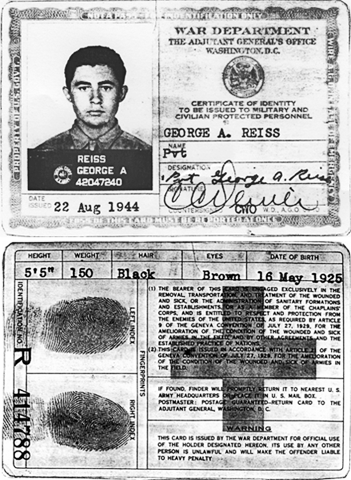 |
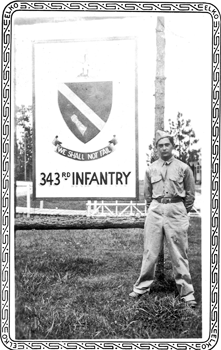 |
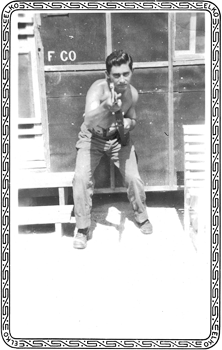 |
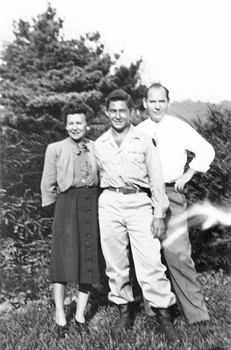
European War Theatre
Le Havre, March 1, 1945 the 343rd Infantry disembarking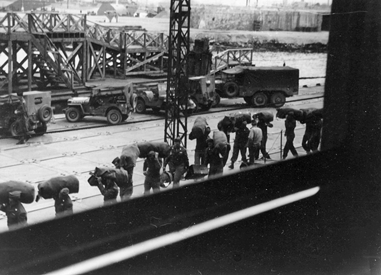 |
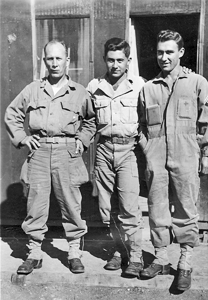 |
|
|
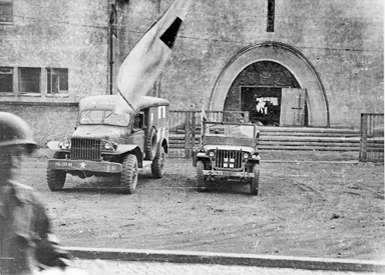
Somewhere in Germany
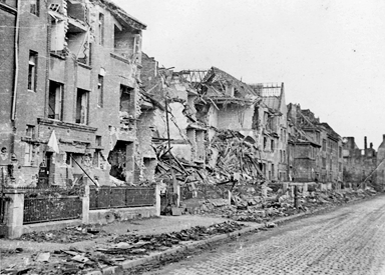 |
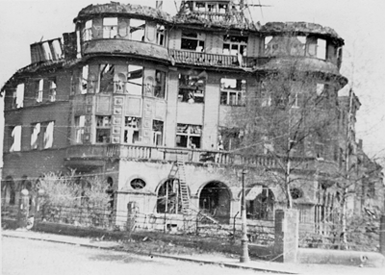 |
|
|
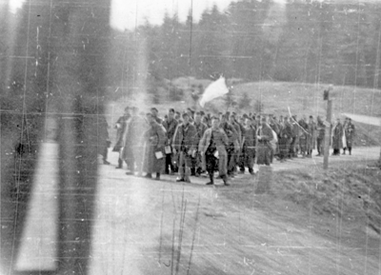 Ruhr Valley, March 1945: Displaced persons surrendering to the medics |
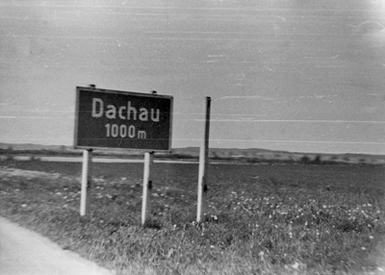 Road sign to Dachau |
|
|
Coming Home from Europe
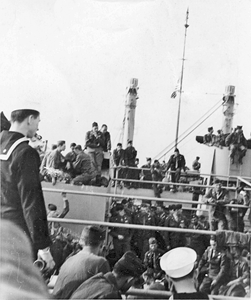 |
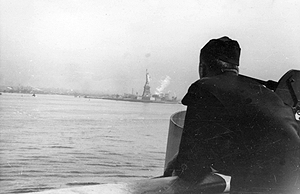 |
In the Philippines (after the war was over)
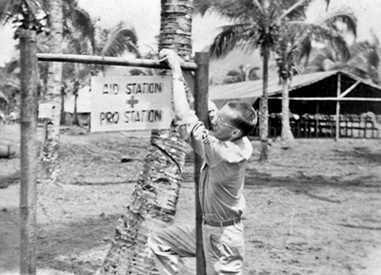 |
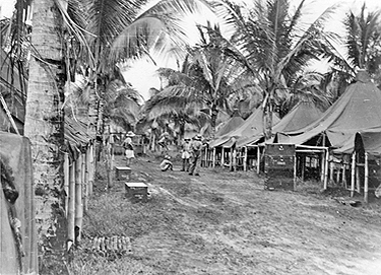 |
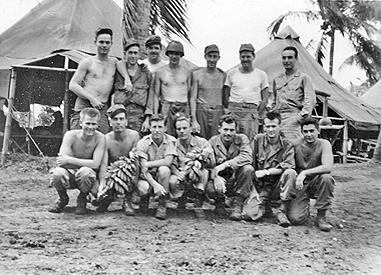 |
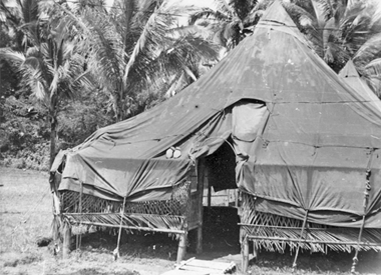 |
Photos Courtesy George Reiss
Introduction
Veterans
Battles
Stamford Service Rolls
Homefront
Exhibit Photos
Opening Day
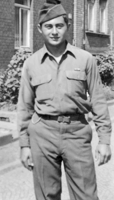 I was drafted out of High School into the Army. I qualified for the ATSP (Army Specialized Training Program), a 13-week program infantry basic training program at Fort Benning, Georgia. Unfortunately, after the 11th week the program was cancelled and I was transferred into the 86th Infantry to be trained in Louisiana. Several months later I was transferred again, this time within the regiment, from the rifle company to the medical detachment where I was trained on as a medic. During this training medics practiced lifesaving techniques on one another as well as on other GIs and by the end I felt we had all become reasonably proficient as medics. I later was sent to Europe toward the end of the war in January/February of 1945. My combat time was six to seven weeks.
I was drafted out of High School into the Army. I qualified for the ATSP (Army Specialized Training Program), a 13-week program infantry basic training program at Fort Benning, Georgia. Unfortunately, after the 11th week the program was cancelled and I was transferred into the 86th Infantry to be trained in Louisiana. Several months later I was transferred again, this time within the regiment, from the rifle company to the medical detachment where I was trained on as a medic. During this training medics practiced lifesaving techniques on one another as well as on other GIs and by the end I felt we had all become reasonably proficient as medics. I later was sent to Europe toward the end of the war in January/February of 1945. My combat time was six to seven weeks.